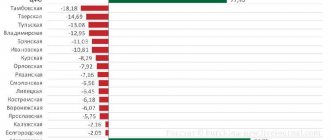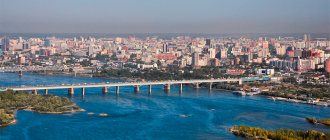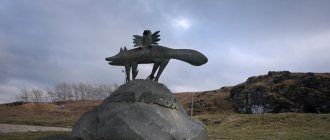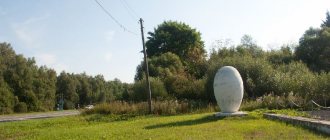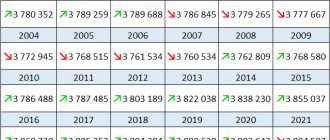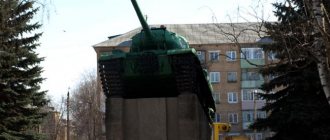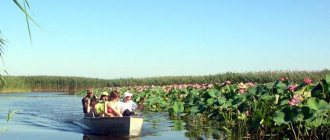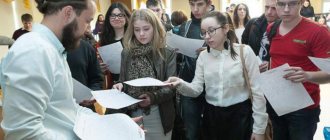City NazyvaevskCountry
Show/hide cards | |||||||||||||||||||||||||||||||
| Nazyvaevsk Moscow |
| Omsk Nazyvaevsk |
K: Settlements founded in 1910
Nazyvaevsk
- a city in Russia, the administrative center of the Nazyvaevsky district of the Omsk region.
Geography
Nazyvaevsk is located in the west of the Omsk region within the Ishim Plain, which is part of the West Siberian Plain. Due to the slight slope of the area, the area is poorly drained. To the south of the city are the Davydovskoye and Rybalovo swamps, to the west is a small lake without a name, to the north is the Platonovskoye swamp[2]. The city is divided almost into two equal halves by the Tyumen-Omsk railway line of the West Siberian Railway.
By road, the distance to the regional center of Omsk is about 210 km. A junction of highways to Tyukalinsk (79 km), Krutinka (55 km) and Isilkul (80 km)[3].
Climate
The climate is sharply continental, with significant temperature differences in winter and summer (according to the Köppen climate classification - humid continental with cool summers (Dfb)). The long-term precipitation norm is 397 mm. The greatest amount of precipitation falls in July - 67 mm, the least in March - 13 mm. The average annual temperature is −0.8 °C[4].
Timezone
| Nazyvaevsk, like the entire Omsk region, is located in the Omsk time zone. The offset relative to UTC is +6:00. Relative to Moscow time, the time zone has a constant offset of +3 hours and is designated in Russia as MSK+3. |
Education[ | ]
The Nazyvaevsky Agrarian-Industrial College operates in the city (since 1954 - a school of mechanization, later Vocational School No. 33)
The DOSAAF driving school (ROSTO) plays an important role in training personnel for the army and the national economy. It was opened in 1954 as a car and motorcycle club, and in 1974 it was renamed a driving school.
In 2002, the main secondary school No. 3 was reorganized into a gymnasium in the city of Nazyvaevsk. In 2007, as part of the development of national projects, a new gymnasium building with 600 seats was built in the city center[33].
3 secondary schools: School No. 1, School No. 2, School No. 4.
4 kindergartens: Kindergarten No. 1, Kindergarten No. 2, Kindergarten No. 3, Kindergarten No. 4.
Institution of additional education "Nazivaevskaya Children's Art School".
Story
Founded in 1910 as the station village of Sibirsky Posad in connection with the construction of the Tyumen-Omsk railway. Passage, and then the Nazyvaevskaya railway station (opened in 1913). The station was named after the village of Nazyvaikha, located 12 km away. In 1913, a warehouse for agricultural implements and machines of the Resettlement Administration was opened[5].
After 1917, the village of Sibirskoye. Since 1933, the village of Nazyvaevka, since 1947, the working village of Novonazyvaevka, the city of Nazyvaevsk since 1956[6].
History[ | ]
Founded in 1910[6] as a station village of Sibirsky Posad at the Nazyvaevskaya railway station on the Tyumen - Kulomzino railway line of the Trans-Siberian Railway[7].
The first builders of the future railway station began to arrive in the villages of Nazyvaikha and Novo-Voskresenka, as well as in the village of Lebedki in the winter of 1909-1910. In March 1910, workers carried timber on sleighs to the Lebedkovsky peasant farmstead, which stood on the site of the current regional communications center, and erected barracks. The history of the city of Nazyvaevsk began with these residential buildings.
In 1910 - 1913, a station, a locomotive depot, a water tower, a track office and a freight house were built, and the railroad bed and rails were laid. For railway workers, standard brick houses for several families each were erected on both sides of the line. A medical outpatient clinic, an elementary school and a police station appeared in Nazyvaevskaya.
The growth of the station village was facilitated by its favorable economic and geographical position; the station intersected with horse-drawn tracks.
In 1913, train traffic began along the line[7].
The crossing, and then the station was named after the village of Nazyvaikha, located 12 versts away. In 1913, a warehouse for agricultural implements and machines of the Resettlement Administration was opened[8].
By the beginning of the First World War, Nazyvaevskaya station became the trade and economic center of a vast agricultural region, the area significantly exceeding the territory of the modern Nazyvaevsky administrative district.
Simultaneously with trade and economic growth, the population of the village increased rapidly. Among the founders of Nazyvaevsk, young people full of vitality and energy predominated.
Before the revolution of 1917, they managed to build a church in the village, and therefore records of marriages, births of children and deaths of the first namesakes can be found in the metric books of the temple in honor of the resurrection of Christ, whose parish included the new settlement. The temple stood in the village of Novo-Voskresenka, 5 miles from the station. It was destroyed around 1949-1950. In 1917, 2,632 people lived in the village at Nazyvaevskaya station.
After 1917, the village of Sibirskoye.
In 1918 it was occupied by the Czechoslovak Corps[7].
In June 1918, units of the rebellious Czechoslovak Corps and a detachment of Cossacks entered Nazyvaevskaya. The population of the village was called to a meeting where the overthrow of Soviet power was announced. A local government body was approved in the village - the Zemskaya Uprava, at whose proposal the station village received the name - Sibirsky Posad. In 1919, Soviet power in the village was restored.
In the summer of 1919 it was taken by the Reds[7].
In 1924, the village entered a new period in its history. As a result of administrative and territorial transformations, it became the center of the Nazyvaevsky district. By this time there were 2,725 people in the village.
In 1932, publication of a local newspaper began here[9].
In 1933, the regional center of Sibirsky Posad was renamed the village of Novo-Nazyvaevka[10].
In 1947, the village of Novo-Nazyvaevka, according to the main indicators of economic and demographic development, was transformed into the working village of Novo-Nazyvaevka, with a population of 10,000 people[7].
Since the 1950s, in Nazyvaevsk, as in all regions of the country, rapid growth of industry and agriculture began, and the social sphere stabilized. A meat processing plant, a tannery, a creamery, a knitting factory, an elevator, an oil depot, and a brick factory are expanding their activities.
In 1950 - 1987, as a result of the state policy of consolidating collective and state farms, over 20 rural settlements of the Nazyvaevsky district were considered unpromising and ceased to exist.
Since 1956 - the city of Nazyvaevsk[6][7].
The initiative to transform the village of Novo-Nazyvaevka into a city belongs to the first secretary of the district committee of the CPSU P.F. Utkin, chairman of the district executive committee F.N. Remez and the Chairman of the Village Council I.F. Begme. After drawing up a detailed report on the main indicators of the economic and demographic development of the regional center in 1956, by the Decree of the Presidium of the Supreme Council of the Russian Federation of January 25, the working village of Novo-Nazyvaevka received the status of a city and was renamed Nazyvaevsk.
In the young city, from 1956 to 1959, over 400 individual residential buildings were built, and the first two-story houses appeared.
In 1956, a section of the Omsk-Nazyvaevskaya railway was electrified, after which the city of Nazyvaevsk was completely electrified.
In 1959, Nazyvaevsk became a city of regional subordination.
At the beginning of 1974, there were railway transport maintenance enterprises, a dairy plant, a meat processing plant and a knitting factory[6].
In 1989, the basis of the economy was food and light industry enterprises[11].
In the 1990s, the region, along with the entire country, experienced a deep socio-economic crisis. As a result, the number of livestock in the area has decreased significantly, and many enterprises have fallen into disrepair.
At the beginning of 1991, the first peasant farms and private enterprise arose in the Nazyvaevsky district.
In 1991 - 1996, changes took place in the system of local authorities. On November 30, 1991, the activities of the City Executive Committee were suspended, and then the District Administration was created. In the first months of 1992, committees and departments of the District Administration were formed, and the District Charter was adopted. A positive factor in the economy of the Nazyvaevsky district in 1997 - 1998 was its gasification.
In 2010, the city celebrated its 100th anniversary. In the same year, the sports and cultural festival “Queen of Sports - Nazyvaevsk - 2010” was held.
Economy
| This article or section needs revision. Please improve the article in accordance with the rules for writing articles. |
| : Incorrect or missing image | This section is missing references to information sources. Information must be verifiable, otherwise it may be questioned and deleted. You may edit this article to include links to authoritative sources. This mark is set May 26, 2015 . |
K:Wikipedia:Articles without sources (type: not specified)
- Butter factory
- Meat processing plant
- Knitting factory "Sport" LLC
- DRSU
- HDSU
- Building materials database
- Reception point for ferrous metals (3 pieces)
- Palace of Culture
- A new church was built
- A new gymnasium was built
- 2 houses built (4 and 5 storeys)
Links[edit]
Notes[edit]
- ^ a b c d e f g
Law No. 467-OZ - ^ a b c
Federal State Statistics Service (2011).
“All-Russian Population Census 2010. Volume 1" [All-Russian Population Census 2010, vol. 1]. All-Russian Population Census 2010 [All-Russian Population Census 2010]
. Federal State Statistics Service. - "26. The size of the permanent population of the Russian Federation by municipalities as of January 1, 2022". Federal State Statistics Service. Retrieved January 23, 2022.
- ^ a b c d e
Law No. 548-OZ - "On the Calculation of Time". Official Internet portal of legal information
. June 3, 2011. Retrieved January 19, 2022. - Post office. Information and computing center of OASU RPO. ( Post office
).
Search for postal service objects ( postal Search for objects
) (in Russian) - Federal State Statistics Service of Russia (May 21, 2004). “The population of Russia, the constituent entities of the Russian Federation as part of federal districts, urban settlements, settlements, settlements is 3 thousand or more people” [Population of Russia, its federal districts, federal constituent entities, districts, urban settlements, rural settlements - administrative centers and rural settlements with a population of more than 3,000 people] (XLS). All-Russian Population Census of 2002 [All-Russian Population Census of 2002]
. - “All-Union Population Census of 1989. The current population of union and autonomous republics, autonomous regions and districts, territories, effects, urban settlements and villages. All-Union Population Census of 1979. National composition of the population by regions of Russia” [All-Union Population Census of 1979. Ethnic composition of the population by regions of Russia] (XLS). All-Union Population Census of 1979 [All-Union Population Census of 1979]
.
1979 - via Demoscope Weekly
(website of the Institute of Demography of the State University - Higher School of Economics.
Excerpt characterizing Nazyvaevsk
- What, master, aren’t you sleeping? - said the Cossack sitting under the truck. - No; and... Likhachev, I think your name is? After all, I just arrived. We went to the French. - And Petya told the Cossack in detail not only his trip, but also why he went and why he believes that it is better to risk his life than to make Lazar at random. “Well, they should have slept,” said the Cossack. “No, I’m used to it,” answered Petya. - What, you don’t have flints in your pistols? I brought it with me. Isn't it necessary? You take it. The Cossack leaned out from under the truck to take a closer look at Petya. “Because I’m used to doing everything carefully,” said Petya. “Some people just don’t get ready, and then they regret it.” I don't like it that way. “That’s for sure,” said the Cossack. “And one more thing, please, my dear, sharpen my saber; dull it... (but Petya was afraid to lie) it was never sharpened. Can this be done? - Why, it’s possible. Likhachev stood up, rummaged through his packs, and Petya soon heard the warlike sound of steel on a block. He climbed onto the truck and sat on the edge of it. The Cossack was sharpening his saber under the truck. - Well, are the fellows sleeping? - said Petya. - Some are sleeping, and some are like this. - Well, what about the boy? - Is it spring? He collapsed there in the entryway. He sleeps with fear. I was really glad. For a long time after this, Petya was silent, listening to the sounds. Footsteps were heard in the darkness and a black figure appeared. -What are you sharpening? – the man asked, approaching the truck. - But sharpen the master’s saber. “Good job,” said the man who seemed to Petya to be a hussar. - Do you still have a cup? - And over there by the wheel. The hussar took the cup. “It’ll probably be light soon,” he said, yawning, and walked off somewhere. Petya should have known that he was in the forest, in Denisov’s party, a mile from the road, that he was sitting on a wagon captured from the French, around which the horses were tied, that the Cossack Likhachev was sitting under him and sharpening his saber, that there was a big black spot to the right is a guardhouse, and a bright red spot below to the left is a dying fire, that the man who came for a cup is a hussar who was thirsty; but he knew nothing and did not want to know it. He was in a magical kingdom in which there was nothing like reality. A large black spot, perhaps there was definitely a guardhouse, or perhaps there was a cave that led into the very depths of the earth. The red spot might have been fire, or maybe the eye of a huge monster. Maybe he is definitely sitting on a wagon now, but it may very well be that he is sitting not on a wagon, but on a terribly high tower, from which if he fell, he would fly to the ground for a whole day, a whole month - keep flying and never reach it . It may be that just a Cossack Likhachev is sitting under the truck, but it may very well be that this is the kindest, bravest, most wonderful, most excellent person in the world, whom no one knows. Maybe it was just a hussar passing for water and going into the ravine, or maybe he just disappeared from sight and completely disappeared, and he was not there. Whatever Petya saw now, nothing would surprise him. He was in a magical kingdom where everything was possible. He looked at the sky. And the sky was as magical as the earth. The sky was clearing, and clouds were moving quickly over the tops of the trees, as if revealing the stars. Sometimes it seemed that the sky cleared and a black, clear sky appeared. Sometimes it seemed that these black spots were clouds. Sometimes it seemed as if the sky was rising high, high above your head; sometimes the sky dropped completely, so that you could reach it with your hand. Petya began to close his eyes and sway. Drops fell. There was a quiet conversation. The horses neighed and fought. Someone was snoring. “Ozhig, zhig, zhig, zhig...” the saber being sharpened whistled. And suddenly Petya heard a harmonious choir of music playing some unknown, solemnly sweet hymn. Petya was musical, just like Natasha, and more than Nikolai, but he had never studied music, did not think about music, and therefore the motives that unexpectedly came to his mind were especially new and attractive to him. The music played louder and louder. The melody grew, moving from one instrument to another. What was called a fugue was happening, although Petya had not the slightest idea what a fugue was. Each instrument, sometimes similar to a violin, sometimes like trumpets - but better and cleaner than violins and trumpets - each instrument played its own and, not yet finishing the tune, merged with another, which started almost the same, and with the third, and with the fourth , and they all merged into one and scattered again, and again merged, now into the solemn church, now into the brightly brilliant and victorious.
Attractions[ | ]
In 2001-2003 it was built with funds from private entrepreneur V.E. Kalinichenko Chapel of St. Olga.
In the spring of 2008, the foundation stone of a new church took place in the city between Pushkin and Serov streets. The temple was built according to the design of the architect A.V. Semakin for three years. On April 9, 2011, a minor consecration of the temple in the name of the holy noble princes Boris and Gleb, erected in the center of Nazyvaevsk, took place[34].
Church of St. Nicholas the Wonderworker.
Monuments
Memorial in memory of those killed during the Great Patriotic War
Monument to Vladimir Ilyich Lenin.
Monument at the site of the battle between the Red partisans and the White Guard troops.
Mass grave of partisans.
Sports[ | ]
In 1988, the Nazyvaevsky district executive committee decided to restore the stadium, which was not completed in 1979. A sports hall 30 by 12 meters, an athletics arena more than 100 meters long, a weightlifting hall, a gym and utility rooms were built. A hockey rink with spacious locker rooms for competition participants was also built. The project also included a 25-meter swimming pool, but due to lack of finance it was not built. All this was adopted by the regional and district authorities in 1990. The new stadium was named in honor of the 45th anniversary of the Victory.
In 1993, a cultural and sports festival “Queen of Sports - Nazyvaevsk - 93” was held in Nazyvaevsk. On the eve of this holiday, a sports hall was built, a running track was covered with armand, a new hockey rink with stands and locker rooms, and a city playground were built.
By order of the Education Committee No. 197 of November 3, 1994, the Children and Youth Physical Training Club (DYUKPP) was created. Additionally, departments for kickboxing, powerlifting, and Greco-Roman wrestling have been opened.
In 1996, the III regional schoolchildren's sports competition was held in Nazyvaevsk. In the same year, young specialists and teachers came to the club.
On July 2, 2010, the city hosted the opening ceremony of the fortieth regional sports and cultural festival “Queen of Sports - Nazyvaevsk -2010” at the stadium named after. 45th anniversary of the Victory. On the approach to the stadium, a wide fair was launched and a stage was installed on which the best creative groups of our district and region performed.[33]
